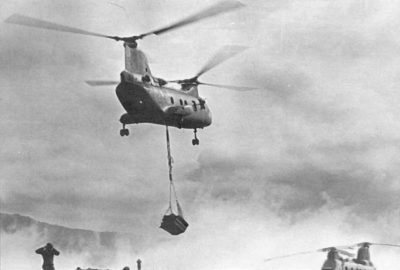
The Battle for Khe Sanh, fifty years ago, involved C-130s, C-123s and lots of helicopters. I like to blog about the brave men who fought in Vietnam because they did not get the thanks they deserved for doing what was asked of them. Khe Sanh was highlighted on the PBS Memorial Day Concert last week. Today, I salute the airplanes that “saved the day” at the Battle of Khe Sanh.
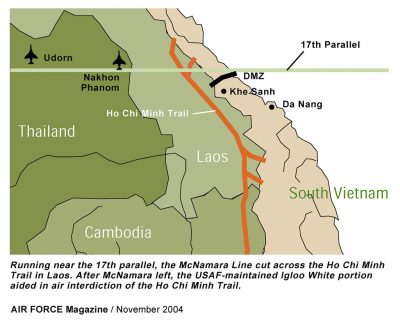
Khe Sanh was a Marine outpost located near the demilitarized zone (DMZ) between North and South Vietnam. It was located in the northwest corner of the country near the neighboring country of Laos. In 1967 United State intelligence detected a buildup of communist forces in the area of Khe Sanh. General Westmoreland, the US Commander, considered Khe Sanh to be critical to protecting that part of free South Vietnam. Therefore the base was reinforced and the runway lengthened.
On January 21, 1968 the North Vietnamese communists attacked Khe Sanh with an estimated 50,000 troops. Khe Sanh was defended by 6,500 Marines & Army. You could say that they were outnumbered. The battle lasted for 77 days. For a brief history of the battle see: https://www.history.com/topics/vietnam-war/battle-of-khe-sanh
Since the Marines were landlocked and surrounded by enemy forces, the only way they could survive was to be reinforced through the air. The runway was damaged and hence instead of 3,500 feet, they only had 2,000 feet of runway to work with.
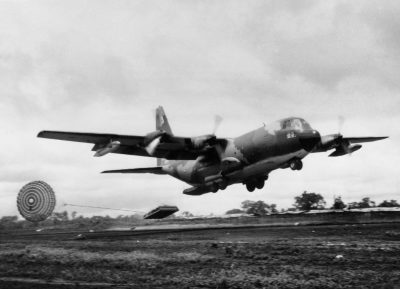
Initially the C-130 (left) brought in many supplies for the beleaguered troops. After a few weeks it was determined that it was too dangerous for C-130s to land. This led to the use of LAPES (Low Altitude Parachute Extraction System). With LAPES the C-130 came in 20 feet off the ground flying at 130 knots. An extraction chute pulled the interlocked cargo pallets out of the aircraft onto the ground. To see video footage check out this clip: https://www.youtube.com/watch?v=GIuoGq4FheQ
The C-130 later went to GPES (Ground Proximity Extraction System). This was a similar idea to a carrier landing in the Navy. A hook dangling from the C-130 cargo bay would catch a wire stretched across the runway which would pull the cargo out of the aircraft.
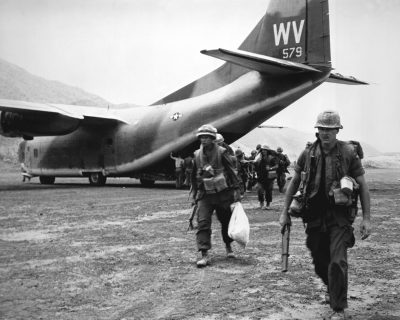
The C-123 (right) continued its landings to reinforce the Marines with supplies and ammunition. Two helicopters also aided in this mission. The CH-47 and CH-53s carried these items and carried out the wounded.
Meanwhile, B-52 bombers (below), AC-130 gunships and AC-47s dropped bombs in the area around the base to help hold back the overwhelming number of communist attackers. Interestingly, the North Vietnamese knew that the B-52 were not allowed to drop bombs within a mile of the base. So they moved operations inside of one mile. When the restriction was reduced to ½ mile the B-52s took out a two battalion attack force. For more video footage see: https://www.youtube.com/watch?v=rJ1n2K1fY6w


On April 8, 1968, the battle ended. The Marines and Army had lasted for 77 days. A decade earlier, in 1954 the French had lost the Battle of Dien Bien Phu to the Communists. Many in the North and in the press had begun to declare Khe Sanh another Dien Bien Phu. Due to some brave Marines and massive airpower, it was not.
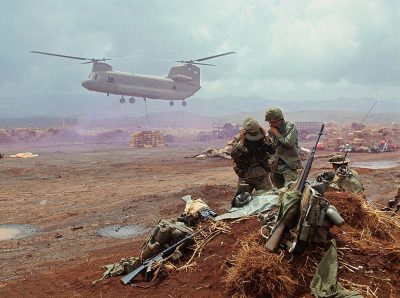
For a detailed account of airpower and Khe Sanh, see: http://www.historynet.com/air-power-in-the-siege-of-khe-sanh.htm
For a video story see: https://www.youtube.com/watch?v=5CVFsRQEQd8
